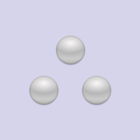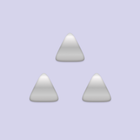Silver nanoparticles absorb and scatter light with extraordinary efficiency. Their strong interaction with light occurs because the conduction electrons on the metal surface undergo a collective oscillation when they are excited by light at specific wavelengths. This oscillation is known as a surface plasmon resonance (SPR), and it causes the absorption and scattering intensities of silver nanoparticles to be much higher than identically sized non-plasmonic nanoparticles. Silver nanoparticle absorption and scattering properties can be tuned by controlling the particle size, shape, and the local refractive index near the particle surface.
The Effect of Size on Optical Properties
The optical properties of spherical silver nanoparticles are highly dependent on the nanoparticle diameter. The extinction spectra of 10 sizes of NanoXact Silver nanoparticles at identical mass concentrations (0.02 mg/mL) are displayed in the figure below. Smaller nanospheres primarily absorb light and have peaks near 400 nm, while larger spheres exhibit increased scattering and have peaks that broaden and shift towards longer wavelengths (known as red-shifting). Paramelle et al. (2014) have published a paper using nanoComposix silver nanoparticles that corroborates our data (extensive supplementary information available here).

The Effect of Local Refractive Index on Optical Properties
Silver nanoparticle optical properties also depend on the refractive index near the nanoparticle surface. As the refractive index near the nanoparticle surface increases, the nanoparticle extinction spectrum shifts to longer wavelengths (known as red-shifting). Practically, this means that the nanoparticle extinction peak location will shift to shorter wavelengths (blue-shift) if the particles are transferred from water (n=1.33) to air (n=1.00), or shift to longerwavelengths if the particles are transferred to oil (n=1.5). The figure below displays the extinction spectrum of a 50 nm silver nanosphere as the local refractive index is increased. Increasing the refractive index from 1.00 to 1.60 results in an extinction peak shift of over 90 nm, moving the peak from the ultraviolet to the visible region of the spectrum.

Similarly, the extinction peak can be tuned by coating aqueous nanoparticles with nonconducting shells including silica (n=1.5), biomolecules (n=1.4-1.45), or aluminium oxide (n=1.58-1.68).
The Effect of Aggregation on Optical Properties
The optical properties of silver nanoparticles change when particles aggregate and the conduction electrons near each particle surface become delocalized and are shared amongst neighbouring particles. When this occurs, the surface plasmon resonance shifts to lower energies, causing the absorption and scattering peaks to red-shift to longer wavelengths. UV-Visible spectroscopy can be used as a simple and reliable method for monitoring the stability of nanoparticle solutions. As the particles destabilize, the original extinction peak will decrease in intensity (due to the depletion of stable nanoparticles), and often the peak will broaden or a secondary peak will form at longer wavelengths (due to the formation of aggregates). In the figure below, the extinction spectrum of 50 nm NanoXact silver is monitored as sodium carbonate is added to the solution (20 mM salt concentration). The rapid and irreversible change in the extinction spectrum clearly demonstrates that the nanoparticles are agglomerating. UV/Visible spectroscopy can be used as a characterization technique that provides information on whether the nanoparticle solution has destabilized over time.

Unaggregated silver nanoparticles will have a yellow color in solution. If the particles aggregate, the solution with appear grey.



